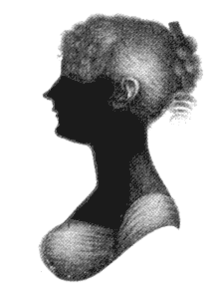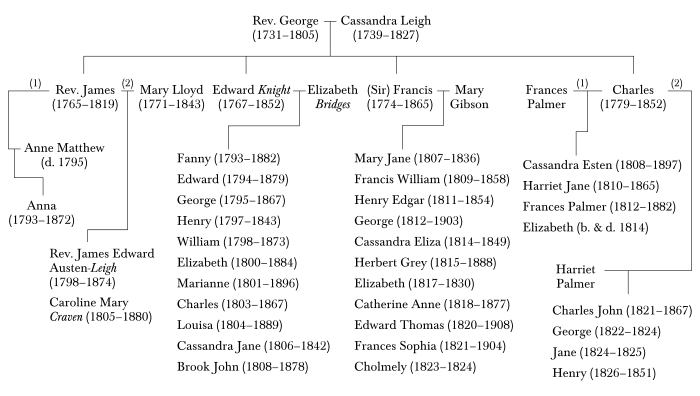Jane Austen's family and ancestry
Jane Austen's parents, George (1731–1805), an Anglican rector, and his wife Cassandra (1739–1827), shared a gentry background.[1] George was descended from wool manufacturers who had risen to the lower ranks of the landed gentry,[2][3] and Cassandra was a member of the aristocratic Leigh family. They married on 26 April 1764 at Walcot Church in Bath.[4][5][6][7] From 1765 to 1801 (for much of Jane's life), George was a rector of Anglican parishes in Steventon, Hampshire and a nearby village. Irene Collins estimates that when George Austen took up his duties as rector in 1764, Steventon comprised no more than about thirty families.[8] From 1773 to 1796, he supplemented his income by farming and teaching three or four boys at a time (who boarded at his home).[9][10]

Austen's immediate family was large—six brothers and one sister:
- James (1765–1819)
- George (1766–1838)
- Edward (1768–1852)
- Henry Thomas (1771–1850)
- Cassandra Elizabeth (1773–1845)
- Francis William (Frank) (1774–1865)
- Charles John (1779–1852)
Her sister Cassandra was an artist, and like Jane, did not marry. She was Austen's closest friend and confidante throughout her life.[11][12][13]
James (matriculated 1779, BA 1783, MA 1788)[14] and Henry (matriculated 1788, BA 1792, MA 1796)[14] were both educated at St John's College, Oxford, as their father had been. Together they edited a literary magazine, The Loiterer. An accomplished poet, James was ordained as an Anglican clergyman, succeeding his father as rector of Steventon.
Of her brothers Austen felt closest to Henry, who became a soldier, then a banker, then (after his bank failed) an Anglican clergyman. Henry was also his sister's literary agent.[15] Henry's large circle of friends and acquaintances in London included bankers, merchants, publishers, painters and actors and he provided Austen with a view of social worlds not normally visible from a small parish in rural Hampshire.[16][17][18] He married their first cousin (and Jane's close friend), Eliza de Feuillide.
George was sent to live with a local family at a young age because, according to Austen biographer Le Faye, he was "mentally abnormal and subject to fits";[19] he may also have been deaf and mute.[20] Charles and Frank served in the navy, both rising to the rank of admiral. Edward was adopted by his fourth cousin, Thomas Knight, inheriting Knight's estate and taking his name in 1812.[21][22]
Family trees
| Austen's ancestry | ||||||||||||||||||||||||||||||||||||||||||||||||||||||||||||||||||||||||||||||||||||||||||||||||||||||||||||||||||||||||||||||||||||||||||||||||||||||||||||||||||||||||||||||||||||||||||||||||||||||||||||||||||||||||||||||||||||||||||||||||||||||||||||||||||||||||||||||||||||||||||||||||||||||||||||||||||||||||||||||||||||||||||||||||||||||||||||||||||||||||||||||||||||||||||||||||||||||||||||||||||||||||||||||||||||||||||||||||||||||||||||||||||||||||||||||||||||||||||||||||||||||||||||||||||||||||||||||||||||||||||||||||||||||||||||||||||||||||||||||||||||||||||||||||||||||||||||||||
|---|---|---|---|---|---|---|---|---|---|---|---|---|---|---|---|---|---|---|---|---|---|---|---|---|---|---|---|---|---|---|---|---|---|---|---|---|---|---|---|---|---|---|---|---|---|---|---|---|---|---|---|---|---|---|---|---|---|---|---|---|---|---|---|---|---|---|---|---|---|---|---|---|---|---|---|---|---|---|---|---|---|---|---|---|---|---|---|---|---|---|---|---|---|---|---|---|---|---|---|---|---|---|---|---|---|---|---|---|---|---|---|---|---|---|---|---|---|---|---|---|---|---|---|---|---|---|---|---|---|---|---|---|---|---|---|---|---|---|---|---|---|---|---|---|---|---|---|---|---|---|---|---|---|---|---|---|---|---|---|---|---|---|---|---|---|---|---|---|---|---|---|---|---|---|---|---|---|---|---|---|---|---|---|---|---|---|---|---|---|---|---|---|---|---|---|---|---|---|---|---|---|---|---|---|---|---|---|---|---|---|---|---|---|---|---|---|---|---|---|---|---|---|---|---|---|---|---|---|---|---|---|---|---|---|---|---|---|---|---|---|---|---|---|---|---|---|---|---|---|---|---|---|---|---|---|---|---|---|---|---|---|---|---|---|---|---|---|---|---|---|---|---|---|---|---|---|---|---|---|---|---|---|---|---|---|---|---|---|---|---|---|---|---|---|---|---|---|---|---|---|---|---|---|---|---|---|---|---|---|---|---|---|---|---|---|---|---|---|---|---|---|---|---|---|---|---|---|---|---|---|---|---|---|---|---|---|---|---|---|---|---|---|---|---|---|---|---|---|---|---|---|---|---|---|---|---|---|---|---|---|---|---|---|---|---|---|---|---|---|---|---|---|---|---|---|---|---|---|---|---|---|---|---|---|---|---|---|---|---|---|---|---|---|---|---|---|---|---|---|---|---|---|---|---|---|---|---|---|---|---|---|---|---|---|---|---|---|---|---|---|---|---|---|---|---|---|---|---|---|---|---|---|---|---|---|---|---|---|---|---|---|---|---|---|---|---|---|---|---|---|---|---|---|---|---|---|---|---|---|---|---|---|---|---|---|---|---|---|---|---|---|---|---|---|---|---|---|---|---|---|---|---|---|---|---|---|---|---|---|---|---|---|---|---|---|---|---|---|---|---|---|---|---|---|---|---|---|---|---|---|---|---|---|---|---|---|---|---|---|---|---|---|---|---|---|---|---|---|---|---|---|---|---|---|---|---|---|---|---|---|---|---|---|---|---|---|---|---|---|---|---|---|---|---|---|---|---|---|---|---|---|---|---|---|---|---|---|---|---|---|---|---|---|---|---|---|---|---|---|---|---|---|---|---|---|---|---|---|---|---|---|---|
[1] Daughter of John Atkins and Mary Dyne (Deed of Settlement dated July 06, 1630); John Atkins is often confused with Sir Jonathan Atkins, whose first wife (m 17/11/1642), Mary Howard (d. 1660), was a descendant of Edward III. [2] Descendant of Edward I | ||||||||||||||||||||||||||||||||||||||||||||||||||||||||||||||||||||||||||||||||||||||||||||||||||||||||||||||||||||||||||||||||||||||||||||||||||||||||||||||||||||||||||||||||||||||||||||||||||||||||||||||||||||||||||||||||||||||||||||||||||||||||||||||||||||||||||||||||||||||||||||||||||||||||||||||||||||||||||||||||||||||||||||||||||||||||||||||||||||||||||||||||||||||||||||||||||||||||||||||||||||||||||||||||||||||||||||||||||||||||||||||||||||||||||||||||||||||||||||||||||||||||||||||||||||||||||||||||||||||||||||||||||||||||||||||||||||||||||||||||||||||||||||||||||||||||||||||||
References
- Honan 1987, pp. 29–30.
- Honan 1987, pp. 11–14.
- Tucker, "Jane Austen's Family", in Grey 1986, p. 143.
- Tomalin 1997, pp. 6, 13–16, 147–151, 170–171.
- Collins 1994, pp. 10–11.
- Fergus, "Biography", in Todd 2005, pp. 5–6.
- Greene, "Jane Austen and the Peerage", in Watt, Jane Austen: A Collection of Critical Essays, 156–157.
- Collins, 86.
- Honan 1987, pp. 14, 17–18.
- Collins 1994, p. 54.
- Tomalin 1997, p. 142.
- Honan 1987, pp. 23, 119.
- Fergus, "Biography", in Todd 2005, pp. 3.
- Foster, Joseph. . 1. p. 41 – via Wikisource. [scan

- Kellynch Hall.
- Honan 1987, pp. 24, 246.
- Collins 1994, p. 17.
- MacDonagh 1991, pp. 50–51.
- Le Faye 2003, p. 22.
- Le Faye 2003, p. 270.
- Tucker, "Jane Austen's Family", in Grey 1986, p. 147.
- Le Faye 2003, pp. 43–44.

